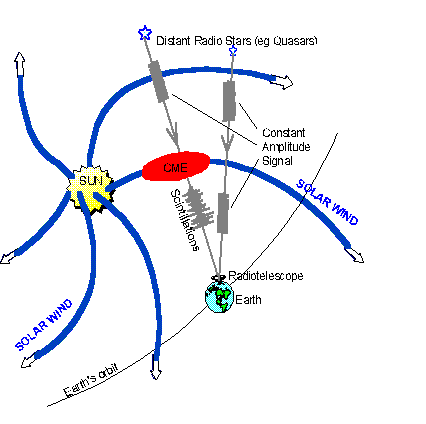Interplanetary Scintillations
Geomagnetic disturbances, (eg. storms) are believed to occur when the Earth encounters a disturbance in the solar wind. This may be in the form of a plasma cloud, stream or region of greater than normal density and/or velocity. Sources of these disturbances in the solar wind may be explosive events on the Sun that produce coronal mass ejections (CMEs), or the less energetic high speed streams that emanate from coronal holes.
Predicting geomagnetic disturbances is even now far from an exact science. Forecast activity does not always eventuate, and occasionally unforeseen activity occurs.
Prior to the use of satellite sensors, geomagnetic prediction methods tended to rely on a 27-28 day repetition interval for recurrent geomagnetic activity, particularly around solar minimum, related to the presence of coronal holes. Ground based sensors, such as those which monitor radio spectral emissions, together with climatology, were used to forecast the likely effects of the energetic solar events.
Satellites have now added two more direct methods by which we may forecast geomagnetic activity. These satellites are usually placed at the Lagrange point of gravitational neutrality between the Sun and the Earth (located about 1.5 million km due sunward from the Earth). Examples of such spacecraft are SOHO, ACE and WIND. SOHO carries on board a white light coronagraph (LASCO) that can see CMEs as they leave the Sun out to many solar radii. If the CME is heading toward the Earth it will appear as a halo around the Sun. (Unfortunately CME's travelling away from the Earth in the opposite direction will also present a halo aspect). Thus halo CME's are of particular interest in geomagnetic forecasting, and should be able to give many ten's of hours warning of an approaching storm. Satellites like ACE and WIND carry in-situ plasma detectors, that directly detect plasma disturbances as they travel past the satellite toward the Earth. The data here is less ambiguous than is the coronagraph data, but the warning time is only about one hour - this is the time taken by the solar wind disturbance to move from the satellite to the Earth, 1.5 million km downwind.
Although it was expected that SOHO would dramatically improve the forecasting of geomagnetic storms, this has not proved to be the case. Not only are there many events seen apparently travelling toward the Earth which 'come to naught', but there are also significant geomagnetic disturbances which occur without prior warning by way of an observed halo CME.
The NASA twin STEREO spacecraft and Solar Dynamics Observatory launched in 2006 and 2010 respectively have improved forecasting the arrival of solar disturbances however, predicting the strength and duration of the resulting geomagnetic storms remains problematic.
One suggestion is the use of a "solar sail", a sail to provide a force due to the solar wind, to orbit a sensor along the Sun-Earth line (as for SOHO), but at a distance much closer to the Sun. In-situ plasma sensors would then be able to provide a warning time much in excess of the current one hour. Such an orbit is not normally feasible (it is termed a non-Keplerian orbit), because it is not gravitationally stable. However, by applying a force to the satellite using a very large and light "sail" and the solar wind, such an orbit is possible, and in fact is under active consideration.
Another technique is the use of a large VHF radio-telescope to measure the scintillation of far distant (generally quasar type) radio sources. In the absence of any disturbances in the interplanetary medium, the signals received from these point radio sources is constant in amplitude. However, if the radio signal passes through a plasma cloud (eg CME) on its way to the Earth it is absorbed and refracted in passing through the plasma. The amplitude and phase of the radio signal as received on the Earth varies from one moment to the next - the signal shows scintillation. The signal from the radio-star (quasar) "twinkles" just as the light from visible stars twinkles as it passes through the atmosphere.
If we measure the signals from several hundred radio stars spread across the sky we can plot a map of the sky. Those areas of our map that show high scintillation activity are those parts of the sky in which there is a coronal mass ejection or other disturbance travelling along. Continued observation will tell us how the CME is moving, whether it will impact the Earth or not and how fast it is travelling. Interplanetary scintillation sensors may thus enable better geomagnetic forecasting.
The frequencies used by radio-telescopes generally range from about 80 to 300 MHz. Lower frequencies are subject to more scintillation, and are thus able to better detect smaller plasma densities. Higher frequencies can see closer in to the Sun, and are thus theoretically able to provide greater warning time. At these frequencies, the radio telescopes need to be very large to provide a beam narrow enough to resolve closely separated radio stars. For instance, at 100 MHz (a wavelength of 3 metres), a linear dimension of 200 metres is required to form a beam of 1 degree in that dimension. The antenna generally employed at these frequencies is an array of many hundreds of dipoles that are electronically combined and steered to scan the sky.

Material prepared by John Kennewell and Andrew McDonald





